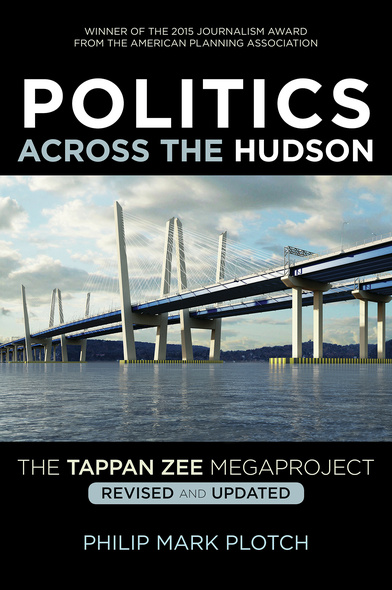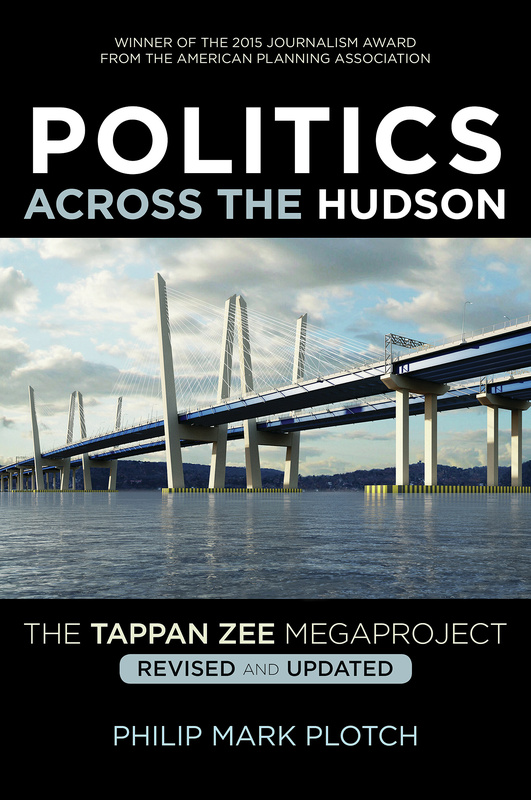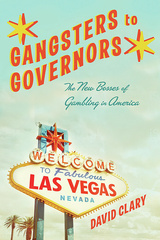
292 pages, 6 1/8 x 9 1/4
7 maps, 4 diagrams, 18 photos
Paperback
Release Date:20 Jun 2018
ISBN:9780813572505
Hardcover
Release Date:03 Aug 2015
ISBN:9780813572499
Politics Across the Hudson
The Tappan Zee Megaproject
Rutgers University Press
Winner of the 2015 American Planning Association New York Metro Chapter Journalism Award
The State of New York built one of the world’s longest, widest, and most expensive bridges—the new Tappan Zee Bridge—stretching more than three miles across the Hudson River, approximately thirteen miles north of New York City. In Politics Across the Hudson, urban planner Philip Plotch offers a behind-the-scenes look at three decades of contentious planning and politics centered around this bridge, recently renamed for Governor Mario M. Cuomo, the state's governor from 1983 to 1994. He reveals valuable lessons for those trying to tackle complex public policies while also confirming our worst fears about government dysfunction.
The State of New York built one of the world’s longest, widest, and most expensive bridges—the new Tappan Zee Bridge—stretching more than three miles across the Hudson River, approximately thirteen miles north of New York City. In Politics Across the Hudson, urban planner Philip Plotch offers a behind-the-scenes look at three decades of contentious planning and politics centered around this bridge, recently renamed for Governor Mario M. Cuomo, the state's governor from 1983 to 1994. He reveals valuable lessons for those trying to tackle complex public policies while also confirming our worst fears about government dysfunction.
Drawing on his extensive experience planning megaprojects, interviews with more than a hundred key figures—including governors, agency heads, engineers, civic advocates, and business leaders—and extraordinary access to internal government records, Plotch tells a compelling story of high-stakes battles between powerful players in the public, private, and civic sectors. He reveals how state officials abandoned viable options, squandered hundreds of millions of dollars, forfeited more than three billion dollars in federal funds, and missed out on important opportunities. Faced with the public’s unrealistic expectations, no one could identify a practical solution to a vexing problem, a dilemma that led three governors to study various alternatives rather than disappoint key constituencies.
This revised and updated edition includes a new epilogue and more photographs, and continues where Robert Caro’s The Power Broker left off and illuminates the power struggles involved in building New York’s first major new bridge since the Robert Moses era. Plotch describes how one governor, Andrew Cuomo, shrewdly overcame the seemingly insurmountable obstacles of onerous environmental regulations, vehement community opposition, insufficient funding, interagency battles, and overly optimistic expectations...
Philip Plotch combines a terrific story with a relentless search for evidence and doses of humor to give us a first-rate portrayal of the political process at work. He recounts the efforts over several decades to replace the aging Tappan Zee Bridge. Through three decades of struggle and failed plans, three governors—George Pataki, Eliot Spitzer, and David Paterson—kept the project alive though often on a 'death watch.' Plotch reveals how Governor Andrew Cuomo picked up the torch, manipulated the facts where he thought it necessary, and overcame many obstacles to begin construction.'
We spend years in traffic yet know little of the brew of politics, bureaucracy, interests, and ideals keeping us there. Planner and political scientist Plotch examines this principle through one transportation planning debacle: the three-decade struggle to refurbish or replace the Tappan Zee Bridge across the Hudson River north of New York City ... Anyone concerned about the place of large infrastructure projects in the modern U.S. should consider this sobering case study.
Plotch has tremendous insight into the challenges of building extraordinarily complex projects in difficult political and fiscal climates. His professional experience and probing questions have enabled him to help explain Planet Albany—a place where thought defies gravity.
Philip Plotch's political history about the replacement of New York's Tappan Zee Bridge should be on the bookshelf of planners and other practicioners, elected officials, community members, and students engaged in or entering megaproject and urban politics debates ... Plotch skillfully tells the painful story of this bridge's evolution through a three-decade saga of conflict between elected officials, engineers, planners, environmentalists, and others who held divergent views about addressing traffic congestion in the corridor. The book is carefully researched and benefits from Plotch's extensive collection of primary materials and interviews with more than 100 key actors, including governors and influential members of the public and advocacy organizations...At times, I felt witness to interviews and his discoveries in real time…At its foundation, this book is a guide to what not to do in megaproject development. …Thus, Politics Across the Hudson provides an accessible and useful primer on what one can expect to surface and evolve potentially during a megaproject's long, winding path in deference to the phrase ‘expect the unexpected.
The Tappan Zee Bridge has been a symbol of infrastructure inaction in the U.S. over the last several decades – until now! New York State's Governor Cuomo has found the way to overcome the bickering among the many stakeholders and actually get to construction of the much needed replacement for this obsolescent and heavily used structure. How he did it, and how decades of issues stood in the way, are well told by Dr. Philip Plotch. This is a treatise for policy makers, planners, engineers, community leaders. Plotch has brought to light the genius in how to get big things done. It should go on your shelf next to your copy of Caro.’
Even with my lifelong interest in traffic congestion, I had much to learn from Politics Across the Hudson. What resonated most with me is the extremely lengthy process of conflicting viewpoints among the many agencies involved in our transportation systems. Nothing gets done fast.
Plotch’s analytical skills are top-notch and his writing is incisive and succinct. He writes with a historian's attention to detail, a political scientist's interest in theory, and a public policy scholar's fascination with how the sausage is actually made.’
Governor David Patterson held about 6 meetings a month. That's according to Professor Philip Plotch who recently published a book, Politics across the Hudson, about the Tappan Zee Bridge and the construction.
The resulting Politics Across the Hudson: The Tappan Zee Megaproject is a short, compelling account of how good politics rarely translates into good public policy. Its 191 pages make for easy reading and its 41 pages of footnotes and bibliography, for authoritative telling
Plotch, a former planning official with the Metropolitan Transportation Authority and the Lower Manhattan Development Corp., writes with depth and wit about engineering, bureaucracy and politics
On list of books for Political Junkies on Your Christmas List
Winner of the prestigious American Planning Association journalism award for its ‘in-depth research, hard hitting analysis and compelling look at the politics behind New York's first major new bridge in more than 50 years.’
Using original documents and conducting numerous interviews with key players, the author went a long distance to unravel this complex process. In so doing, he managed to eloquently, and in great detail, trace the project’s political, planning and bureaucratic evolution.
Philip Plotch gives a brief history and sums up the future of the Tapen Zee Bridge project in this short video (http://youtu.be/PltWbA1aBhI)
a wonderful book about this infrastructure megaproject
How the governor latched onto decades of planning to achieve his new Mario M. Cuomo Bridge' by Philip Mark Plotch
Cuomo astride our infrastructure: He got the Second Ave. Subway and new Tappan Zee over the finish line, but how?' op-ed by Philip Plotch
Why can't we build anything? Plus Lawyers (!), SoftBank pressures and more Amazon HQ2' by Danny Crichton and Arman Tabatabai
Truck traffic surges on Gov. Mario M. Cuomo Bridge, drops at George Washington Bridge' by Thomas C. Zambito and Frank Esposito
How Gov. Thomas Dewey engineered Tappan Zee Bridge toll money to edge out Port Authority' by Thomas C. Zambito
Plotch’s Politics Across the Hudson makes abundantly clear, understanding how infrastructure declines and deteriorates is enormously important.
Saint Peter’s Resident Transportation Expert Appears on One-on-One with Steve Adubato'
https://www.saintpeters.edu/news/2019/08/01/saint-peters-resident-transportation-expert-appears-on-one-on-one-with-steve-adubato/
PHILIP MARK PLOTCH is an assistant professor of political science and director of the Master in Public Administration program at Saint Peter’s University in Jersey City. He is the former director of World Trade Center Redevelopment and Special Projects for the Lower Manhattan Development Corporation, and the former manager of planning for New York’s Metropolitan Transportation Authority.
List of Illustrations
List of Tables
Acknowledgments
Guides to This Book
Introduction
1 The I-287 Corridor: From Conception to Congestion
2 Searching for Congestion Solutions (1980–1988)
3 Finalizing Plans for the HOV Lane (1988–1995)
4 Killing the HOV Lane (1994–1997)
5 Permut’s Rail Line and Platt’s Bridge
6 Pataki’s Task Force: Raising Expectations Sky High (1998–2000)
7 The Thruway Authority versus Metro-North (2000–2006)
8 Eliot Spitzer Doesn’t Have Enough Steam (2007–2008)
9 David Paterson: The Overwhelmed Governor (2008–2010)
10 Andrew Cuomo Takes Charge in 2011
11 Public Reaction and Cuomo’s Campaign (2011–2012)
12 Lost Opportunities and Wasted Resources
Conclusion
Notes
Bibliography
Index





